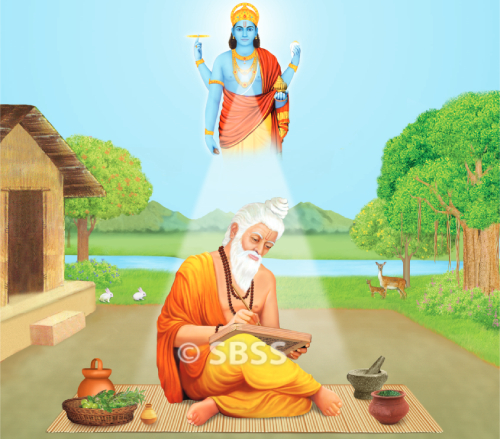Ayurveda for a healthy life ! – 35/2024 on 1.9.2024

Janapadodhwansa
(Natural calamities and epidemics)
‘Janapad’ is a large area of land such as a city or a State. ‘Udhvansa’ means getting destroyed. To manage the diseases, Ayurvedic physicians need to stock medicines well before any natural disaster strikes, since it is likely that medicinal plants in the respective areas may become polluted due to the disasters.
A natural calamity or an epidemic may affect a region or
a country involving many people of different constitutions taking different diet and having different strength, resistance and digestive power. The factors that affect people in common are Wind, Water, Country, and Season concerned. Various microbes can invade the body through the vitiated Air, Water or Food and lead to infectious diseases.
1. Wind or air :Storms can devastate a particular region. Similarly the air may be polluted by chemicals or bad odours, smoke, dust, moisture and sand. Air pollution predisposes to epidemics of infectious fevers, cold, cough, breathlessness, headache, vomiting and eye diseases.
2. Water : Water is polluted by excreta of man and animals; chemicals, putrefying matter, bacteria etc. Such water may have altered smell, colour, taste and temperature. If aquatic animals like fish and frogs do not survive or start leaving the reservoir, that particular reservior should be taken as unfit for human use. Epidemics of cholera, gastro-enteritis, worm infestations, abdominal distention, fever, cough, breathlessness, cold, colicky pain, jaundice, anaemia, oedema, skin diseases, elephantiasis, gulma, heart disease, diseases of throat and head are caused by polluted water.
3. Region or country : The country may be affected by excess or inadequate rainfall or pollution by human or animal excreta, chemicals or worms. Excessive humidity in anupa (wet) region predisposes to kaphaja disorders example cough, breathlessness, oedema, tumours etc. Wars also devastate the areas around all the fronts.
4. Time and season : Abnormal season has characteristics opposite to the normal season or exhibits the usual environmental changes of the season in an excessive or deficient degree. This leads to deaths due to heat stroke or subnormal temperature etc. or predisposes to respiratory infection when exposed to heavy showers.
A. Infectious diseases : Epidemics of infectious diseases are caused by microorganisms, when the body resistance is lowered as a result of vitiated air, water, country or season. Ayurveda mentions that these microorganisms are present all over that is in earth, water and in atmosphere. They are microscopic and naturally cannot be visualised. They enter the body in large numbers, which may amount to millions. These are termed as Jantu, Sookshmakrumi, Bhootas or Rakshasas and these Bhootas are supposed to be controlled by various divine powers termed as ‘grahas’. These micro organisms are classified as those growing on blood (Raktada), muscles (Mansada), fat (Vasada), nervous tissue (Majjada), nails (Nakhada), teeth (Dantada), and those thriving on heart (Hrudayachara). They grow in unclean, moist and dark areas.
प्रसङ्गात् गात्रसंस्पर्शान्निःश्वासात् सहभोजनात् ।
एकशय्यासनाच्चैव वस्त्रमाल्यानुलेपनात् ।। – मा. नि. कुष्ठनिदान
They are transmitted from person to person through clothes, garlands, direct contacts, food, breath or intercourse. These are described in chapters on krumiroga, fever, natural calamities and epidemics, grahabadha, tuberculosis, ear-nose-throat diseases, skin diseases and diseases of children in Ayurvedic texts.
Sterilisation by boiling and by exposure to the various medicated fumes is advised example medicinal fumes of Guggulu, Agaru, Sarjarasa, White pepper, Vacha, Salt, Nimba (neem leaves) and ghee of goat’s milk is an effective antibhoota measure.
Many of the predisposing factors which lead to epidemic for example atmospheric changes like excessive rainfall, low atmospheric pressures etc. are beyond human control. It is difficult to explain why a particular epidemic affects only a particular region and takes toll of lives of masses in that region. Ayurveda ascribes the epidemics to non-religious behaviour and the sinful acts of the masses. Epidemics take place when the fruits of action of the bad deeds become mature.
Treatment is divided under five categories
A. Pancha-karma that is purification of body by purgative, enemas etc.
B. Administration of tonics that is rasayana
1. Maintenance of high morale.
2. This is achieved by following rules of good conduct and by worshipping God.
3. Prevention of the epidemic or the calamity or its effects by boiling drinking water, not eating food outside etc.
4. Treating the persons affected by appropriate measures and medicines.
5. As a last resort or earlier, if it is difficult to withstand its effects, one should leave the region expected to be affected by the calamity.

 Take Disciplinary Action Against Charitable Hospitals Violating Rules : Surajya Abhiyan
Take Disciplinary Action Against Charitable Hospitals Violating Rules : Surajya Abhiyan Detergent found in ice-creams, phosphoric acid in soft drinks !
Detergent found in ice-creams, phosphoric acid in soft drinks ! Vitamins
Vitamins Spiritual research on popular biscuits in the market by Maharshi Adhyatma Vishwavidyalay
Spiritual research on popular biscuits in the market by Maharshi Adhyatma Vishwavidyalay Ability to cook is necessary for healthy relationships
Ability to cook is necessary for healthy relationships